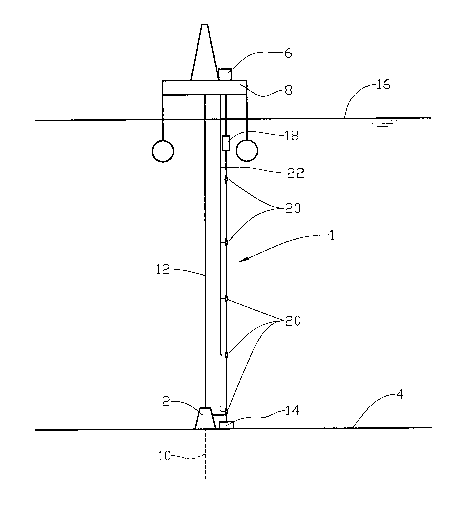Some of the information on this Web page has been provided by external sources. The Government of Canada is not responsible for the accuracy, reliability or currency of the information supplied by external sources. Users wishing to rely upon this information should consult directly with the source of the information. Content provided by external sources is not subject to official languages, privacy and accessibility requirements.
Any discrepancies in the text and image of the Claims and Abstract are due to differing posting times. Text of the Claims and Abstract are posted:
| (12) Patent Application: | (11) CA 2657557 |
|---|---|
| (54) English Title: | PIPE STRING DEVICE FOR CONVEYING A FLUID FROM A WELL HEAD TO A VESSEL |
| (54) French Title: | DISPOSITIF DE TRONCON DE CANALISATION PERMETTANT DE TRANSPORTER UN FLUIDE DEPUIS UNE TETE DE PUITS JUSQU'A UNE CUVE |
| Status: | Deemed Abandoned and Beyond the Period of Reinstatement - Pending Response to Notice of Disregarded Communication |
| (51) International Patent Classification (IPC): |
|
|---|---|
| (72) Inventors : |
|
| (73) Owners : |
|
| (71) Applicants : |
|
| (74) Agent: | SMART & BIGGAR LP |
| (74) Associate agent: | |
| (45) Issued: | |
| (86) PCT Filing Date: | 2007-07-13 |
| (87) Open to Public Inspection: | 2008-01-17 |
| Availability of licence: | N/A |
| Dedicated to the Public: | N/A |
| (25) Language of filing: | English |
| Patent Cooperation Treaty (PCT): | Yes |
|---|---|
| (86) PCT Filing Number: | PCT/NO2007/000269 |
| (87) International Publication Number: | WO 2008007973 |
| (85) National Entry: | 2009-01-12 |
| (30) Application Priority Data: | ||||||
|---|---|---|---|---|---|---|
|
A method and pipe string device (1) for conveying a fluid from a well head (2) to a vessel (8), the fluid in the pipe string (1) needing, for well-technical reasons, to be given a flow boost, and the pipe string (1) being provided with at least one injection point for a driving fluid, the injection point may be constituted by an ejector (20).
Le procédé et dispositif de tronçon de canalisation (1) de la présente invention permet de transporter un fluide depuis une tête de puits (2) jusqu'à une cuve (8), le fluide dans le tronçon de canalisation (1) devant, pour des raisons techniques liées aux puits, se voir attribuer une impulsion d'écoulement, et le tronçon de canalisation (1) étant équipé d'au moins un point d'injection pour un fluide moteur, lequel point d'injection peut être constitué par un éjecteur (20).
Note: Claims are shown in the official language in which they were submitted.
Note: Descriptions are shown in the official language in which they were submitted.

2024-08-01:As part of the Next Generation Patents (NGP) transition, the Canadian Patents Database (CPD) now contains a more detailed Event History, which replicates the Event Log of our new back-office solution.
Please note that "Inactive:" events refers to events no longer in use in our new back-office solution.
For a clearer understanding of the status of the application/patent presented on this page, the site Disclaimer , as well as the definitions for Patent , Event History , Maintenance Fee and Payment History should be consulted.
| Description | Date |
|---|---|
| Time Limit for Reversal Expired | 2013-07-15 |
| Application Not Reinstated by Deadline | 2013-07-15 |
| Inactive: Abandon-RFE+Late fee unpaid-Correspondence sent | 2012-07-13 |
| Deemed Abandoned - Failure to Respond to Maintenance Fee Notice | 2012-07-13 |
| Letter Sent | 2009-10-02 |
| Inactive: Office letter | 2009-10-02 |
| Inactive: Delete abandonment | 2009-08-18 |
| Inactive: Correspondence - Transfer | 2009-08-04 |
| Deemed Abandoned - Failure to Respond to Notice Requiring a Translation | 2009-07-20 |
| Inactive: Office letter | 2009-06-03 |
| Inactive: Cover page published | 2009-05-26 |
| Inactive: Notice - National entry - No RFE | 2009-04-21 |
| Inactive: Incomplete PCT application letter | 2009-04-20 |
| Inactive: First IPC assigned | 2009-04-03 |
| Application Received - PCT | 2009-04-02 |
| Inactive: Declaration of entitlement - PCT | 2009-03-31 |
| Inactive: Single transfer | 2009-03-31 |
| National Entry Requirements Determined Compliant | 2009-01-12 |
| Application Published (Open to Public Inspection) | 2008-01-17 |
| Abandonment Date | Reason | Reinstatement Date |
|---|---|---|
| 2012-07-13 | ||
| 2009-07-20 |
The last payment was received on 2011-06-27
Note : If the full payment has not been received on or before the date indicated, a further fee may be required which may be one of the following
Please refer to the CIPO Patent Fees web page to see all current fee amounts.
| Fee Type | Anniversary Year | Due Date | Paid Date |
|---|---|---|---|
| Basic national fee - standard | 2009-01-12 | ||
| MF (application, 2nd anniv.) - standard | 02 | 2009-07-13 | 2009-01-12 |
| Registration of a document | 2009-03-31 | ||
| MF (application, 3rd anniv.) - standard | 03 | 2010-07-13 | 2010-06-21 |
| MF (application, 4th anniv.) - standard | 04 | 2011-07-13 | 2011-06-27 |
Note: Records showing the ownership history in alphabetical order.
| Current Owners on Record |
|---|
| AGR SUBSEA AS |
| Past Owners on Record |
|---|
| ROGER STAVE |